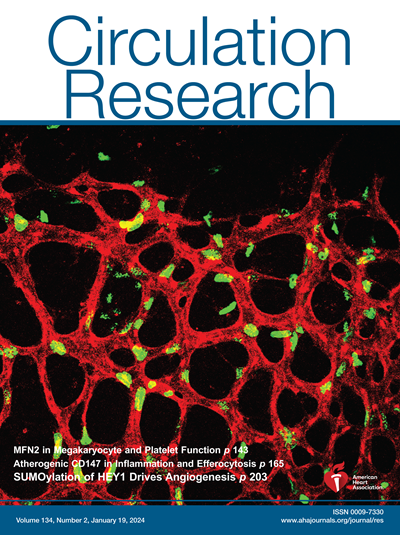心脏对代谢压力的有丝分裂反应迟钝是导致高房血症的原因之一。
IF 16.2
1区 医学
Q1 CARDIAC & CARDIOVASCULAR SYSTEMS
引用次数: 0
摘要
背景代谢重塑和线粒体功能障碍是射血分数降低型心力衰竭的特征。方法在高脂饮食和 Nω-硝基精氨酸甲酯诱导的高射血分数心力衰竭小鼠模型中,通过 31P NMR 光谱测定心脏能量,并通过 13C 同位素分析评估底物氧化概况。结果HFpEF心脏的磷酸肌酸含量较低,磷酸肌酸/ATP比率降低,与射血分数降低的心力衰竭相似。从高频低氧血症心脏分离的线粒体中观察到呼吸功能下降,活性氧生成增加,表明线粒体功能障碍。心脏底物氧化谱显示,HFpEF 心脏高度依赖脂肪酸氧化,这与射血分数降低的心衰相反,但与高脂饮食心脏相似。然而,高脂饮食心脏的磷酸肌酸/ATP比率和线粒体功能得以维持。我们发现,尽管肥胖程度相似,但高脂饮食心脏中的有丝分裂被激活,而高密度脂蛋白EF心脏中的有丝分裂没有被激活,这表明高密度脂蛋白EF心脏中的线粒体质量控制反应受损。通过使用人类诱导多能干细胞衍生的心肌细胞有丝分裂报告物,我们发现脂肪酸负荷会刺激有丝分裂,而抑制脂肪酸氧化则会消除这种现象。结论HFpEF心脏对代谢应激的不适应会损害线粒体质量控制并导致发病,而促进脂肪酸氧化则可改善这一问题。本文章由计算机程序翻译,如有差异,请以英文原文为准。
Blunted Cardiac Mitophagy in Response to Metabolic Stress Contributes to HFpEF.
BACKGROUND
Metabolic remodeling and mitochondrial dysfunction are hallmarks of heart failure with reduced ejection fraction. However, their role in the pathogenesis of HF with preserved ejection fraction (HFpEF) is poorly understood.
METHODS
In a mouse model of HFpEF, induced by high-fat diet and Nω-nitrol-arginine methyl ester, cardiac energetics was measured by 31P NMR spectroscopy and substrate oxidation profile was assessed by 13C-isotopmer analysis. Mitochondrial functions were assessed in the heart tissue and human induced pluripotent stem cell-derived cardiomyocytes.
RESULTS
HFpEF hearts presented a lower phosphocreatine content and a reduced phosphocreatine/ATP ratio, similar to that in heart failure with reduced ejection fraction. Decreased respiratory function and increased reactive oxygen species production were observed in mitochondria isolated from HFpEF hearts suggesting mitochondrial dysfunction. Cardiac substrate oxidation profile showed a high dependency on fatty acid oxidation in HFpEF hearts, which is the opposite of heart failure with reduced ejection fraction but similar to that in high-fat diet hearts. However, phosphocreatine/ATP ratio and mitochondrial function were sustained in the high-fat diet hearts. We found that mitophagy was activated in the high-fat diet heart but not in HFpEF hearts despite similar extent of obesity suggesting that mitochondrial quality control response was impaired in HFpEF hearts. Using a human induced pluripotent stem cell-derived cardiomyocyte mitophagy reporter, we found that fatty acid loading stimulated mitophagy, which was obliterated by inhibiting fatty acid oxidation. Enhancing fatty acid oxidation by deleting ACC2 (acetyl-CoA carboxylase 2) in the heart stimulated mitophagy and improved HFpEF phenotypes.
CONCLUSIONS
Maladaptation to metabolic stress in HFpEF hearts impairs mitochondrial quality control and contributed to the pathogenesis, which can be improved by stimulating fatty acid oxidation.
求助全文
通过发布文献求助,成功后即可免费获取论文全文。
去求助
来源期刊

Circulation research
医学-外周血管病
CiteScore
29.60
自引率
2.00%
发文量
535
审稿时长
3-6 weeks
期刊介绍:
Circulation Research is a peer-reviewed journal that serves as a forum for the highest quality research in basic cardiovascular biology. The journal publishes studies that utilize state-of-the-art approaches to investigate mechanisms of human disease, as well as translational and clinical research that provide fundamental insights into the basis of disease and the mechanism of therapies.
Circulation Research has a broad audience that includes clinical and academic cardiologists, basic cardiovascular scientists, physiologists, cellular and molecular biologists, and cardiovascular pharmacologists. The journal aims to advance the understanding of cardiovascular biology and disease by disseminating cutting-edge research to these diverse communities.
In terms of indexing, Circulation Research is included in several prominent scientific databases, including BIOSIS, CAB Abstracts, Chemical Abstracts, Current Contents, EMBASE, and MEDLINE. This ensures that the journal's articles are easily discoverable and accessible to researchers in the field.
Overall, Circulation Research is a reputable publication that attracts high-quality research and provides a platform for the dissemination of important findings in basic cardiovascular biology and its translational and clinical applications.
 求助内容:
求助内容: 应助结果提醒方式:
应助结果提醒方式:


